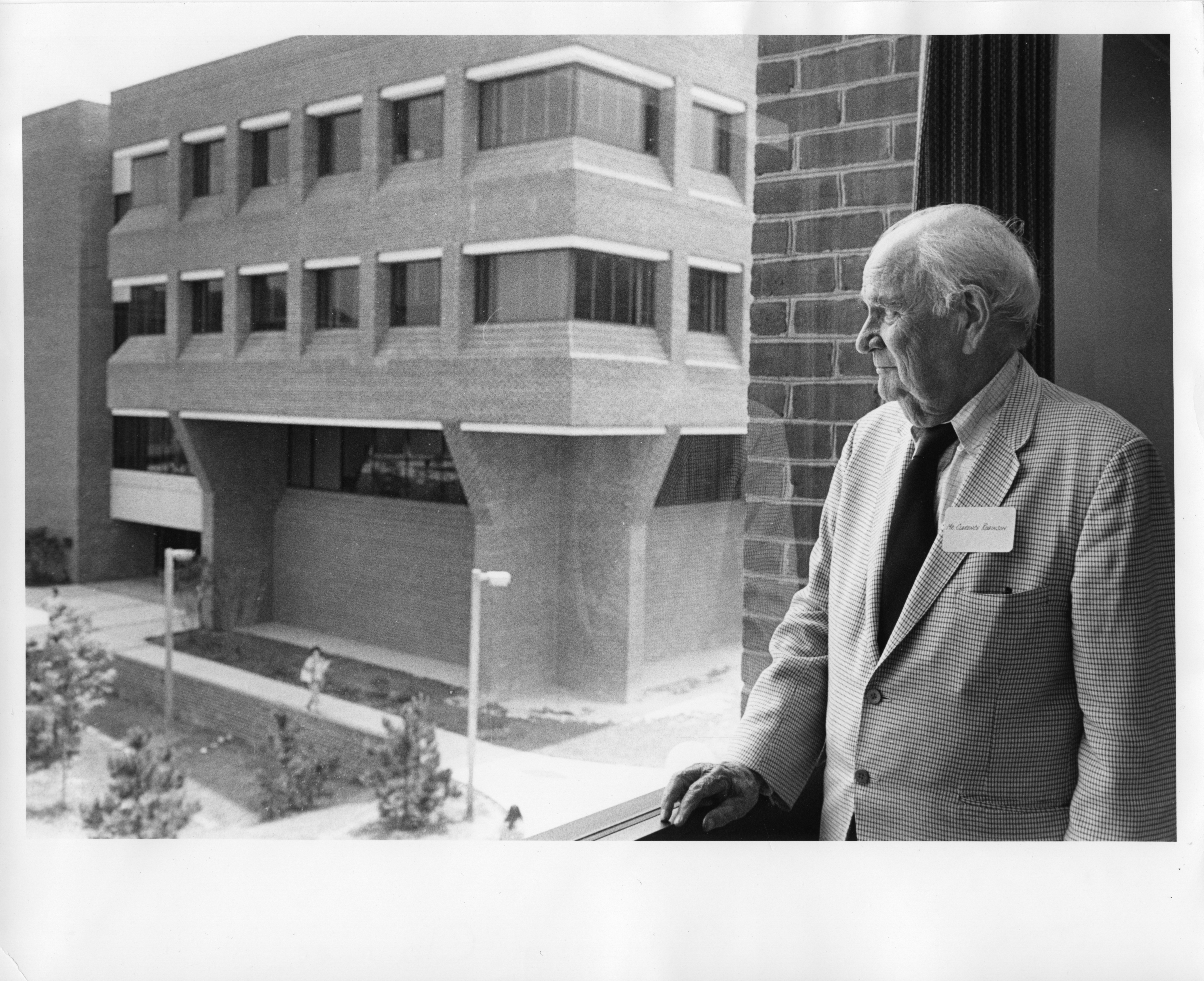This is Part 1 of a multi-part series. To read Part 2, visit https://vault217.gmu.edu/?p=8196
As you might have noticed by now, our beloved Robinson Hall is being prepared for demolition so that a new and more-modern Robinson Hall can rise up in its place by 2022. Robinson opened in September 1975 and was named for Clarence Robinson, a long-time friend and benefactor to the university. Before then it was simply known as Academic II. Robinson’s Wing A cost about $2.4 million to construct and was opened in July 1975.

Academic II (later named Robinson Hall) dated April 30, 1975. This was taken about 3 months before completion of construction. George Mason University Broadside photograph collection #R0135, Box 11, Page 13, Frame 6.
Many of us probably remember Robinson as a dreary place to take a class because there were very few windows (most of the classrooms and labs were on the interior of the building, while the faculty offices were on the outer edge). There were no study areas (except for the hallway floors), and there was only one (very slow) elevator. I took the stairs (which zig-zagged front and back as you went up and down) 99.9% of the time. But with a rapidly growing student population, Robinson fit the bill at the time. It housed several departments, more than 40 classrooms and labs, and it had a vending machine area that rivaled many classrooms in size.
In late 1970 the 568-acre Fairfax Campus of George Mason College comprised six buildings and a parking lot. The tiny North, South, East, and West Buildings opened in September 1964 and hosted classrooms, labs, administrative and faculty offices, and the dining hall. Fenwick Library and the Lecture Hall were completed in the fall of 1967. A seventh building, the Arts and Sciences Building, which was later named Thompson Hall, was still under construction and would not open until September 1971. With plans to become an independent university in 1972, George Mason had begun a monumental transformation.

Aerial photograph of George Mason College, Fairfax campus, 1971. Photo shows Fenwick Library, Lecture Hall, and North, South, East, West, and Arts and Sciences (later Thompson Hall) Buildings. George Mason University Facilities Management records #R0017, Box 138. Special Collections Research Center, George Mason University Libraries.
In September of 1970 enrollment at Mason was 2,398. Three years later it had more than doubled to 4,926. Academic program offerings also increased from 25 in 1970 to 38 in 1973. The steady increase in enrollment, coupled with Mason’s ambitious academic expansion program, necessitated additional buildings.
Beginning in 1970, a new wave of construction began at Mason. Key buildings would begin to fill the first forty cleared acres of the original 147 donated by the Town of Fairfax in 1959. Aerial photography of the campus from that era showed some kind of construction, no matter what year the photo was taken. At one point in 1974, three major construction projects within yards of each other (the Fenwick Library Tower, Robinson A, and the Student Union) were in progress simultaneously. Construction trailers and vehicles, steel framing, and large piles of dirt were an everyday part of the campus landscape for much of the 1970s.

Aerial photograph of George Mason University , Fairfax campus, 1974. Photo shows simultaneous construction work on Fenwick Library (at right), Academic II (bottom center), and Student Union (at left). George Mason University Facilities Management records #R0017, Box 139. Special Collections Research Center, George Mason University Libraries.
Clarence J. Robinson was a successful Northern Virginia businessman who had tremendous interest in the education of the area’s citizens. In 1939 he founded the Robinson Terminal Warehouse Corporation in Springfield, and in 1957 he became president of the First and Citizen Bank in Alexandria. Robinson joined the George Mason College Advisory Board in 1964, and served as its chairman until 1970, while also making generous donations to the school, including some real estate property in the early 1970s. Upon his death in 1983, Robinson’s will stipulated that one-half of his estate was to be given to George Mason University.
In 1975 George Mason University’s Academic II building was renamed Clarence J. Robinson Hall in his honor.

Clarence J. Robinson with Robinson Hall in the background, ca. 1978. George Mason University photograph collection #R0120, Box 56, Folder 9. Special Collections Research Center, George Mason University Libraries.
A few years ago the University arrived at the conclusion that Robinson Hall and the infrastructure that serves it has outlived its useful life. A new building and surrounding landscape was designed to replace this hard-working building. This past summer Robinson Hall A was closed in preparation for demolition and the construction of a building and public area that will transform the center of the Fairfax Campus. More about the project will be forthcoming in Part II!
Follow Special Collections Research Center on Social Media at our Facebook, Instagram, and Twitter accounts. To search the collections held at Special Collections Research Center, go to our website and browse the finding aids by subject or title. You may also e-mail us at speccoll@gmu.edu or call 703-993-2220 if you would like to schedule an appointment, request materials, or if you have questions. Appointments are not necessary to request and view collections.



Robinson Hall: The Beginning of the End (for now), Part 1